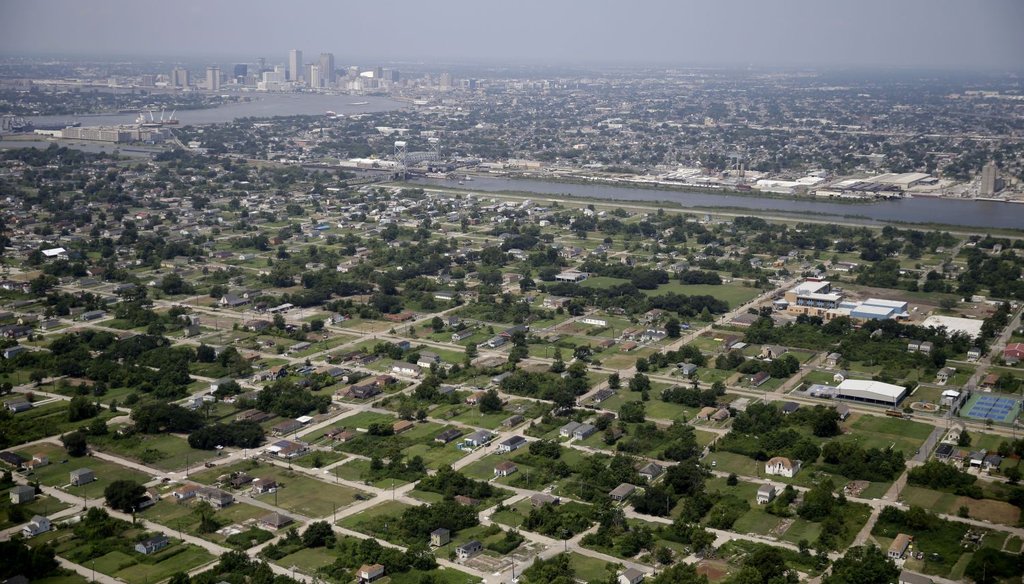Stand up for the facts!
Our only agenda is to publish the truth so you can be an informed participant in democracy.
We need your help.
I would like to contribute

The city of New Orleans, July 29, 2015. (AP Photo)
Editor’s note: On the 10th anniversary of Hurricane Katrina, PolitiFact has partnered with The Lens to report on President Barack Obama’s campaign promises about the storm’s impact on New Orleans. The Lens is a nonprofit, public-interest newsroom that covers the New Orleans area.
A decade after Katrina, the largest city the hurricane struck is still on the road to recovery.
The initial federal response to the catastrophe received a boatload of criticism, including from then-candidate Barack Obama during his 2008 presidential bid. Visiting New Orleans, Obama blasted how the Bush administration dealt with the hurricane.
"America failed the people of New Orleans and the Gulf Coast long before that failure showed up on our television sets. America failed them again during Katrina. We cannot — we must not — fail for a third time," Obama said on Aug. 27, 2007. "But tragically, that's what's happening today. And that's what needs to change."
Obama then laid out his plan for New Orleans and made a few promises. On the 10th anniversary of Hurricane Katrina, we looked at eight of those promises centered on the city of New Orleans and found that Obama has largely kept his pledges to protect against future storms, restore wetlands and rebuild schools and hospitals. In some cases, such as housing relief or improving public transit, things haven’t turned out exactly as envisioned. He’s broken one promise entirely, he’s kept four and compromised on three others.
Strengthening levees
Obama pledged to strengthen New Orleans’ broken levees by 2011, with the ultimate goal of protecting the city from a Category 5 storm. That would be stronger than Katrina when it reached New Orleans.
The federal government has delivered on the first part of the promise, largely funding and building a $14.5 billion levee system. That system was in place by Obama’s self-imposed deadline, but it won’t be completely finished until 2017. The new levees will also be "armored" with a protective layer, strong enough to weather another Katrina.
The new system, however, isn’t invulnerable. While the levees wouldn’t collapse in the face of a powerful hurricane, they’re not tall enough to keep water from spilling over the embankments and into the city. No further action has been taken to bulk up the levees to protect against a Category 5 storm. We rated this a Compromise.
Restoring wetlands
For years, Louisiana has been losing wetlands, barrier islands and marshes that buffer populated areas from storms. The state has an ambitious, untested plan to reverse some of the damage over 50 years, but it doesn’t have the $50 billion it’s estimated to cost.
Obama pledged to help restore those wetlands and close a shipping channel that funneled storm surge into the city.
The shipping channel was closed soon after Obama took office, although the U.S. Army Corps of Engineers hasn’t restored wetlands eroded by the channel.
His administration capitalized on another environmental disaster, the Deepwater Horizon oil spill, to deliver on his pledge to help restore the coast. In all, Louisiana will get $8 billion from BP for coastal restoration. Though the state will need more money, that’s an important down payment. We rated this Promise Kept.
Housing relief
Despite Obama’s promise to quickly assist New Orleans homeowners with storm-damaged properties and to increase the supply of rental units in the city, the "Road Home" for many has been long and rocky.
Under the $9.7 billion Road Home Homeowner Assistance Program, nearly every eligible homeowner — more than 130,000 — has received a federal grant. But it took years to clear the backlog, rather than Obama’s original goal of two months.
As for rebuilding damaged rental properties, the Obama administration carried forward plans from the Bush administration to rebuild as many as 51,000 apartments at a cost of $1.4 billion. But just 16,100 units have been constructed at a cost of about $948 million. The rest of the money is gone, reallocated to other recovery programs.
As for public housing, there will be half as many units in New Orleans as before the storm once current projects are complete.
Demand for rental properties and affordable housing remains high and unmet. There are more than 13,000 families on the Section 8 housing waiting list, and about 5,000 on the waiting list for public housing. Across the board, rent prices are rising faster than incomes in New Orleans.
While the Obama administration has attempted to address housing problems, it’s fallen short of meeting its goals. We rated this a Compromise.
Establishing new crime programs
New Orleans still consistently ranks as one of the deadliest cities in the country, but Obama has addressed crime by providing funding, personnel, and support.
As Obama vowed, his administration revived the Community Oriented Policing Services program in 2009, which began during the Clinton era but was curtailed during the Bush years. From 2011 to 2014, the New Orleans Police Department received nearly $7 million from the U.S. Justice Department to support 50 officers.
Obama has also met his goal of establishing "an integrated regional crime control partnership." Local law enforcement collaborates with several federal agencies. The FBI, for example, has assisted investigations and trained police.
We rated this Promise Kept and also noted an important initiative that wasn’t a campaign pledge: Under Obama’s watch, the Justice Department spearheaded an effort to usher in a new era of increased accountability and transparency at NOPD, a department long plagued by corruption and police brutality. Reforms include documenting interrogations on video, recruiting a more diverse force, and training officers to eliminate discrimination in policing.
Improving transportation
Obama pledged to improve transportation in New Orleans by integrating public transit across parish lines, possibly to Baton Rouge. Yet the system is worse today than it was before Katrina, in part because federal ambitions and funding didn’t always align with local decisions.
Though there has been considerable federal funding, New Orleans overall still has lost more than half of its pre-Katrina bus and streetcar service, with just one bus line in one neighboring parish.
Up until 2013, the U.S. Transportation Department picked up the $2.3 million tab for a commuter bus between New Orleans and Baton Rouge. It asked Louisiana to contribute, but the state declined, and the service ended.
The department also gave New Orleans $45 million to build a new streetcar line in the city in 2013. It did little to improve transit, however, especially considering its price tag. Unforeseen costs forced the city's public transit agency to dip into local funds, and riders ended up paying more for an unpredictable commute.
Because local and state officials also shoulder some of the blame, we rated this a Compromise.
Rebuilding schools
Secretary of Education Arne Duncan infamously called Hurricane Katrina "the best thing that happened to the education system in New Orleans." While that comes off as a bit tone-deaf, efforts to rebuild school infrastructure in the city have been successful, so we rated this one Promise Kept.
The Obama administration has awarded Louisiana and New Orleans billions in federal funds to repair schools. The Federal Emergency Management Agency, for example, gave New Orleans $1.8 billion to repair about 80 schools. While the money is not enough to cover the entire recovery effort, Obama promised to "help," not solve all of the problems. We rated this Promise Kept.
Rebuilding hospitals
We rated Obama’s pledge to build hospitals a Promise Kept, while noting that it hasn’t been all smooth sailing.
In August 2015, a new $1.1 billion public hospital opened near downtown New Orleans, replacing the city’s shuttered Charity Hospital. FEMA chipped in $475 million for the facility (plus a portion of about $1 billion to rebuild hospitals across the state). Another FEMA-funded facility opened in July 2014.
A new veterans hospital is projected to open in February 2016, but after many setbacks and challenges. For one, its $1 billion price is about 60 percent more than anticipated, and its completion has been delayed for a year and a half.
Direct oil revenue for coastal protection
Obama also promised to share revenue from "offshore oil and gas drilling to increase coastal hurricane protection." We rated this one a Promise Broken, because his administration seems to have reversed its position altogether.
Since 2006, Louisiana, Texas, Mississippi and Alabama have shared 37.5 percent of offshore drilling revenue. That pie is expected to grow larger in the coming years, but the slice going to the four states will be capped at $500 million beginning in 2018.
Numerous attempts by Louisiana lawmakers to lift the cap have been unsuccessful, opposed often by the Obama administration. In his 2016 budget proposal, the president, for his own part, seeks to eliminate revenue sharing altogether.
The bottom line: The time table for increased royalty payments hasn't changed under Obama, and his administration has since proposed to take revenue sharing off the table entirely.
Our Sources
See promise updates for sources.
























